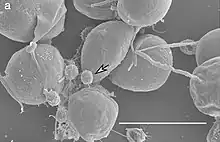Melainabacteria
| Melainabacteria | |
|---|---|
 | |
| SEM of Chlorella sorokiniana and attached Vampirovibrio chlorellavorus cells.
Scale bar, 5.0 μm. | |
| Scientific classification | |
| Domain: | Bacteria |
| (unranked): | Cyanobacteria-Melainabacteria group |
| Phylum: | Melainabacteria Di Rienzi et al. 2013[1] |
| Order | |
| |
Melainabacteria is a phylum related to Cyanobacteria. Organisms belonging to this phylum have been found in the human gut and various aquatic habitats such as groundwater. By analyzing genomes of Melainabacteria, predictions are possible about the cell structure and metabolic abilities. The bacterial cell is similar to cyanobacteria in being surrounded by two membranes. It differs from cyanobacteria in its ability to move by flagella (like gram-negative flagella), though some members (e.g. Gastranaerophilales) lack flagella.[2] Melainabacteria are not able to perform photosynthesis, but obtain energy by fermentation.
The genomes of Melainabacteria organisms isolated from ground water indicate that the organism has the capacity to fix nitrogen.
Melainabacteria lack linked electron transport chains but have multiple methods to generate a membrane potential which can then produce ATP via ATP synthase. They are able to use Fe hydrogenases for H
2 production that can be consumed by other microorganisms. Melainabacteria from the human gut also synthesize several B and K vitamins, which suggests that these bacteria are beneficial to their host because they are consumed along with plant fibers.[3][4]
Classification
Melainabacteria contains the following taxa:
- Order "Candidatus Caenarcaniphilales" Soo et al. 2014
- Genus "Ca. Caenarcanum" Soo et al. 2014
- "Ca. Caenarcanum bioreactoricola" Soo et al. 2014
- Genus "Ca. Caenarcanum" Soo et al. 2014
- Order "Ca. Gastranaerophilales" Soo et al. 2014
- Genus "Ca. Gastranaerophilus" Soo et al. 2014
- "Ca. Gastranaerophilus phascolarctosicola"
- Genus "Ca. Gastranaerophilus" Soo et al. 2014
- Order "Ca. Obscuribacterales" Soo et al. 2014
- Genus "Ca. Obscuribacter" Soo et al. 2014
- "Ca. Obscuribacter phosphatis" Soo et al. 2014
- Genus "Ca. Obscuribacter" Soo et al. 2014
- Order "Vampirovibrionales" Soo et al. 2015
- Family "Vampirovibrionaceae" Soo et al. 2015
- Genus Vampirovibrio Gromov & Mamkayeva 1972 ex Gromov & Mamkaeva 1980
- Vampirovibrio chlorellavorus Gromov & Mamkayeva 1972 ex Gromov & Mamkaeva 1980
- Genus Vampirovibrio Gromov & Mamkayeva 1972 ex Gromov & Mamkaeva 1980
- Family "Vampirovibrionaceae" Soo et al. 2015
References
- ↑ Di Rienzi, S.C., Sharon, I., Wrighton, K.C., Koren, O., Hug, L.A., Thomas, B.C., Goodrich, J.K., Bell, J.T., Spector, T.D., Banfield, J.F., and Ley, R.E. "The human gut and groundwater harbor non-photosynthetic bacteria belonging to a new candidate phylum sibling to Cyanobacteria." eLife (2013) 2:e01102.
- ↑ Soo RM, Woodcroft BJ, Parks DH, Tyson GW, Hugenholtz P. (2015) Back from the dead; the curious tale of the predatory cyanobacterium Vampirovibrio chlorellavorus. PeerJ 3:e968 https://doi.org/10.7717/peerj.968
- ↑ Di Rienzi, SC; Sharon, I; Wrighton, KC; Koren, O; Hug, LA; Thomas, BC; Goodrich, JK; Bell, JT; Spector, TD; Banfield, JF; Ley, RE (2013). "The human gut and groundwater harbor non-photosynthetic bacteria belonging to a new candidate phylum sibling to Cyanobacteria". eLife. 2: e01102. doi:10.7554/eLife.01102. PMC 3787301. PMID 24137540.
- ↑ Soo, RM; Skennerton, CT; Sekiguchi, Y; Imelfort, M; Paech, SJ; Dennis, PG; Steen, JA; Parks, DH; Tyson, GW; Hugenholtz, P (2014). "An expanded genomic representation of the phylum cyanobacteria". Genome Biol Evol. 6 (5): 1031–45. doi:10.1093/gbe/evu073. PMC 4040986. PMID 24709563.